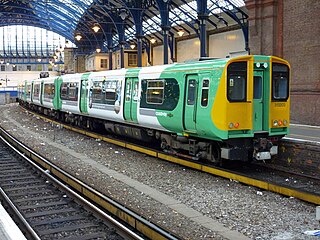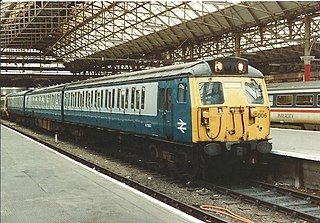
The British Rail Mark 3 is a type of passenger carriage developed in response to growing competition from airlines and the car in the 1970s. A variant of the Mark 3 became the rolling stock for the High Speed Train (HST).
The Lancashire and Yorkshire Railway (LYR) built suburban electric stock for lines in Liverpool and Manchester. The line between Liverpool to Southport began using electric multiple units (EMUs) on 22 March 1904, using a third rail 625 V DC. Additional trains were later built for this route, and in 1913 incompatible stock for the route to Ormskirk. Lightweight units were built to run on the Liverpool Overhead Railway.

The British Rail Class 313 was a dual-voltage electric multiple unit (EMU) train built by British Rail Engineering Limited's Holgate Road carriage works between February 1976 and April 1977. They were the first production units that were derived from British Rail's 1971 prototype suburban EMU design which, as the BREL 1972 family, eventually encompassed 755 vehicles over five production classes. They were the first second-generation EMUs to be constructed for British Rail and the first British Rail units with both a pantograph for 25 kV 50 Hz AC overhead lines and contact shoe equipment for 750 V DC third rail supply. They were, additionally, the first units in Britain to employ multi-function automatic Tightlock couplers, which include electrical and pneumatic connections allowing the coupling and uncoupling of units to be performed unassisted by the driver whilst in the cab.

The British Rail Class 455 is an electric multiple unit passenger train built by BREL between 1982 and 1985. It is operated on suburban services in Greater London and Surrey by South Western Railway, as well as formerly by Southern.

The British Rail Class 310 was a slam-door, alternating current (AC) electric multiple unit (EMU) introduced in 1965 as part of the West Coast Main Line electrification project. They were initially classified as Class AM10 units before the introduction of the TOPS classification system. Constructed at BR's Derby Carriage and Wagon Works. They consisted of four carriages - a second class driving trailer, a second class trailer, a second class motor car and a composite driving trailer. The maximum speed was 75 miles per hour (121 km/h). A glass partition behind the driver's cab enabled passengers in the leading and rear coaches to view the line ahead or behind.

The British Rail Class 201 six-car diesel-electric multiple units (DEMUs) were built in 1957–1958 at Eastleigh and underframes were built at Ashford.

The A-series trains are a class of electric multiple unit built by Walkers Limited in Maryborough, Queensland for Transperth between 1991 and 1999. When introduced in 1991, the A-series trains became the first electric passenger trains to operate in Western Australia and until 2004, were the only type of train in use on the Perth suburban rail network.

The British Rail Class 504 was a unique type of electric multiple unit that ran on 1,200 V DC third rail with side-contact current collection. All other mainline UK third rails have the electric "shoe" on top of the rail. The type was used only on the Bury Line between Manchester and Bury. They were built in 1959 at Wolverton Works, and the body was a standard type used for several electrification schemes of the time, but the high DC voltage through a side-contact third rail was unique in Britain. The trains replaced the previous five-car units built by the Lancashire and Yorkshire Railway (LYR) for the route, which had inaugurated this electrification scheme in 1916.

The British Rail Class 318 is an electric multiple unit (EMU) passenger train which operates in west central Scotland. The units were introduced on 29 September 1986 as part of the electrification of the Ayrshire Coast Line between Glasgow Central and Ayr/Ardrossan with alternating current (AC) overhead lines. Their use was extended to Largs in January 1987. They were also used on the Inverclyde Line in small numbers. The trains currently operate Argyle Line, Cathcart Circle Line, North Clyde Line, Whifflet Line and Inverclyde Line services. Following the withdrawal of the Class 314 fleet in 2019, these units are the oldest working EMUs in Scotland, having been in revenue-earning service for more than 37 years.

The British Rail Class 432 (4-REP) electric multiple unit passenger trains were built by BR at York Works from 1966 to 1967 and in 1974. The units were built to power the TC trailer units on services on the South West Main Line. Fifteen four-car units were eventually built. The motor coaches were new build, but the trailers were converted from Mk1 hauled stock. They were initially classified as Class 441 and numbered 3001–3015. This was later changed to Class 430, under which they spent the majority of their working lives. Shortly before withdrawal they were reclassified Class 432 and the units were renumbered as 2001–2015. The fleet had a lifespan of 26 years.
Push–pull is a configuration for locomotive-hauled trains, allowing them to be driven from either end of the train, whether having a locomotive at each end or not.

An electric multiple unit (EMU) is an electric self-powered train, capable of operating in multiple with other EMUs and without the need for a locomotive; these are typically passenger trains with accommodation in every vehicle and a driving position at each end. The term can also be used to describe a train that is a permanent formation with a non-driving power car, such as the Advanced Passenger Train. As of December 2010, two-thirds of the passenger carriages in Great Britain are formed in EMUs.

An electric multiple unit or EMU is a multiple-unit train consisting of self-propelled carriages using electricity as the motive power. An EMU requires no separate locomotive, as electric traction motors are incorporated within one or a number of the carriages. An EMU is usually formed of two or more semi-permanently coupled carriages, but electrically powered single-unit railcars are also generally classed as EMUs. The great majority of EMUs are passenger trains, but versions also exist for carrying mail.

The British Rail Class 304 were AC electric multiple units designed and produced at British Rail's (BR) Wolverton Works.

The British Rail Class 210 was a type of diesel-electric multiple unit (DEMU) passenger train designed and constructed by British Rail Engineering Limited's Derby Litchurch Lane Works.
Tze-Chiang, also Tzu-chiang or Ziqiang, is a type of limited express train service operated by Taiwan Railway (TR). Of the five service classes operated by TR, the Tze-Chiang service is the fastest. Ticketing is done on the basis of mileage.

The SNCF Class Z 50000, also known as the 'Francilian', or 'NAT' is a type of dual-voltage electric multiple unit trainset designed in the 2000s. It is commuter rail system serving Paris and its Île-de-France suburbs on the Transilien network. Departing stations are Gare du Nord, Gare de l'Est and Gare Saint-Lazare.

The EMU1200 series is a series of electric multiple unit passenger trains operated by Taiwan Railways Administration (TRA). The train was originally known as the EMU200 series until all of its cars were refurbished between 2002 and 2004. It is one of the trains that are used for the Tze-Chiang Limited Express.

The DDJ1 is a first generation high-speed electric multiple unit built for China Railway, built by Zhuzhou Electric Locomotives, Changchun Railway Vehicles, Sifang Railway Vehicles, Tangshan Passenger vehicle factory, Nanjing Puzhen and developed by Zhuzhou Electric Locomotive Research Centre. It was built in 1999, and was an experimental vehicle, with only one set built, as it did not enter mass production. The design was well received as part of national science in the 9th five year plan. The DDJ1 is in a push–pull configuration, with only one locomotive in the set and the other end being a trailer with a driver's cabin.

The KDZ1A "Chuncheng" was an early attempt at building an electric multiple unit in China with the participation of Changchun Railway Vehicles, Zhuzhou Institute and Kunming railway bureau. Development was completed in 1999 in time for the Kunming World Horticultural Exposition. As its predecessor, the KDZ1 never operated commercially, the KDZ1A became the first Chinese EMU to be in revenue service, although it was in service for only 10 years before being withdrawn.



























